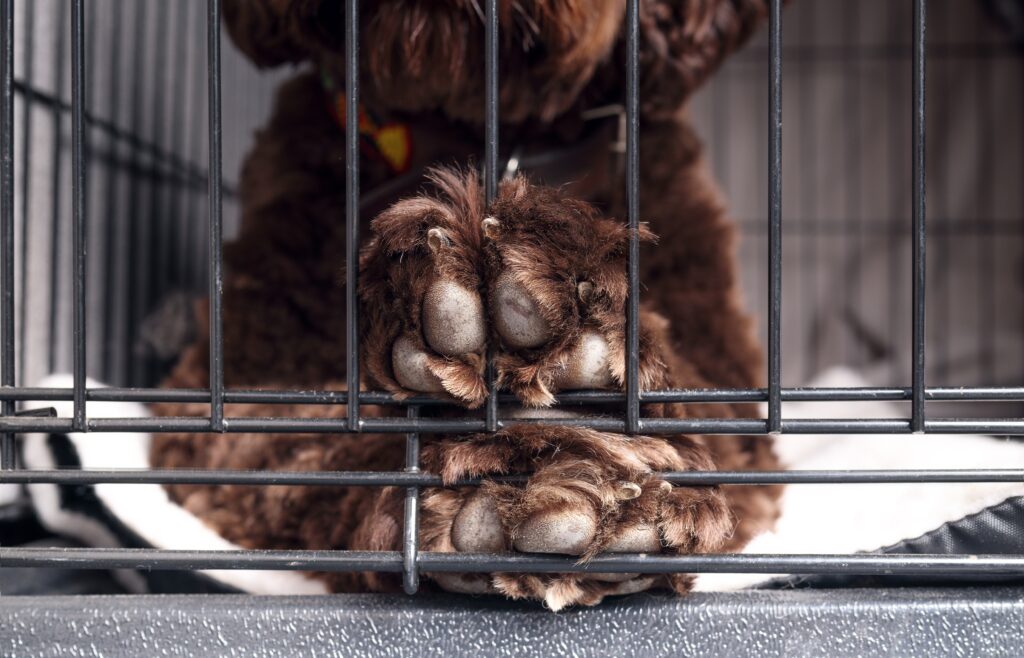Locking a puppy in a crate at night is recommended and can be very beneficial for both training and safety, but it should be done properly.
Here’s why…
Benefits of Crating a Puppy at Night
- Safety and Security
- Crates provide a safe environment where your puppy is protected from hazards (e.g., chewing on wires, eating something harmful, or getting into trouble in the house when you’re asleep).
- Puppies often have a strong den instinct, and many feel secure and comfortable in a crate, which can help them settle down for the night.
- Helps with Potty Training
- Puppies have a natural instinct to avoid soiling their sleeping area. Using a crate helps them develop bladder control, as they learn to hold it until they’re let outside.
- A crate can help limit accidents in the house and encourage a routine for potty breaks.
- Promotes Good Sleeping Habits
- A crate provides a designated resting area, helping your puppy establish a bedtime routine. It’s a quiet space for them to relax, and over time, they’ll associate the crate with sleep and relaxation.
- Prevents Destructive Behavior
- When unsupervised at night, puppies can get into mischief—chewing furniture, eating something they shouldn’t, or making a mess. A crate keeps them safe and prevents these behaviors while you’re sleeping.
How to Make Crating Comfortable for Your Puppy
- Introduce the Crate Gradually
- Start by letting your puppy explore the crate during the day, making it a positive experience. Use treats, toys, and praise to encourage them to go in.
- Avoid forcing your puppy into the crate. Gradually build up their comfort with it over a few days or weeks.
- Size the Crate Appropriately
- The crate should be large enough for your puppy to stand, turn around, and lie down comfortably, but not so large that they have space to potty in one corner.
- If the crate is too big, consider using a divider to make it smaller until your puppy grows into it.
- Set Up the Crate for Comfort
- Add a soft bed or blanket inside, making it cozy and inviting.
- Avoid placing the crate near the door or in high-traffic areas. Choose a quiet spot where your puppy can sleep undisturbed.
- Establish a Routine
- Set a consistent bedtime and morning routine. Take your puppy outside for a potty break just before crate time.
- Gradually extend the time they spend in the crate as they get older, and avoid crating for more than a few hours at a time during the day, especially for young puppies.
- Don’t Use the Crate as Punishment
- Never use the crate as a form of punishment. It should always be a positive, safe space for your puppy, not a place where they feel confined or scared.
How Long Can a Puppy Stay in a Crate at Night?
- Young Puppies (8–10 weeks) – They may need to go outside for potty breaks every 2–3 hours, so they might not be able to hold it all night yet. You may need to get up once or twice to take them out.
- Older Puppies (12 weeks and up) – As puppies get older, they can hold their bladder for longer, and by 16 weeks, they may be able to stay in the crate for 6–8 hours overnight without needing a potty break.
Crating your puppy at night is a safe, effective training tool that helps with potty training, provides them a secure space to sleep, and prevents unwanted behavior. It’s important to ensure the crate is a positive and comfortable environment for your puppy, and that they are let out for potty breaks as needed, especially in the early stages.


